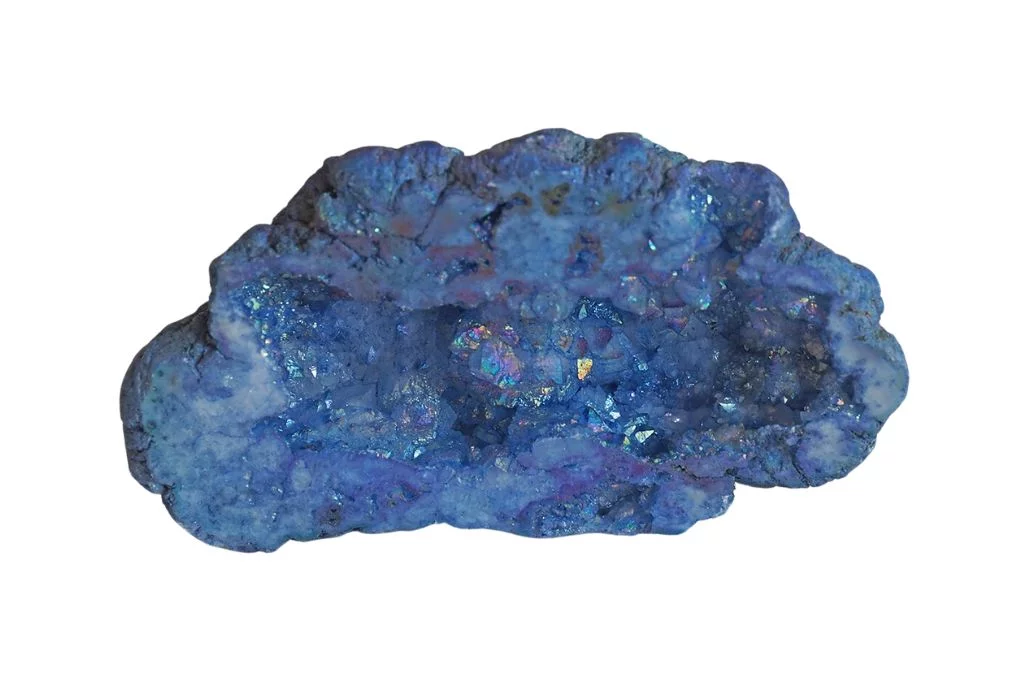The Distinctive Appearance of Blue John
Blue John, also known as Derbyshire Spar, is a striking and rare form of fluorite crystal renowned for its unique coloration and banding patterns. This semi-precious gemstone typically displays a mesmerizing combination of purple and yellow hues, with occasional streaks of blue, white, and even red. The vibrant purple ranges from deep lavender to pale lilac, while the yellow varies from bright canary to soft cream.
Structural Characteristics
Blue John exhibits a distinctive banded structure, with alternating layers of color creating a visually captivating effect. These bands can be straight, wavy, or even form intricate swirls, giving each specimen a one-of-a-kind appearance. The crystal’s structure is relatively soft, with a Mohs hardness of 4, making it suitable for carving and shaping into decorative objects.
Notable Physical Features
One of the most remarkable aspects of Blue John is its fluorescence under ultraviolet light, where it emits a brilliant blue glow. This property adds to its allure and makes it popular among mineral collectors. The crystal often forms in cubic or octahedral shapes, though it can also occur in massive form. When cut and polished, Blue John reveals a translucent to transparent quality, allowing light to pass through and enhance its color patterns.
Unique Aspects
What truly sets Blue John apart is its extreme rarity and limited geographical occurrence. Found only in the Treak Cliff Cavern and Blue John Cavern near Castleton in Derbyshire, England, this crystal is one of the scarcest minerals in the world. Its limited supply and distinctive appearance have made Blue John highly sought after for centuries, prized by royalty and collectors alike. The crystal’s ability to be worked into thin, almost translucent sheets further adds to its versatility and appeal in decorative arts.
Historical and Cultural Significance of Blue John
Blue John, also known as Derbyshire Blue John or Blue John Fluorite, is a semi-precious mineral with a rich history dating back to Roman times. This rare variety of fluorite is found only in the Treak Cliff Cavern and Blue John Cavern in Derbyshire, England. Its distinctive purple-blue and yellow banded appearance made it highly prized by 18th and 19th-century aristocrats, who used it to create ornamental objects and jewelry.
Metaphysical Associations
In the realm of crystal healing and metaphysics, Blue John is believed to possess powerful properties. It is said to enhance intuition, promote mental clarity, and facilitate communication with higher realms. Many practitioners associate Blue John with the third eye and crown chakras, believing it can aid in spiritual growth and psychic development. The stone is also thought to provide protection against negative energies and foster emotional balance.
Common Uses and Applications
Traditionally, Blue John was used to create decorative items such as vases, bowls, and ornamental inlays for furniture. Today, it continues to be popular in jewelry making, with artisans crafting unique pendants, earrings, and rings. In alternative healing practices, Blue John is often used in crystal grids, meditation, and energy work. Some people carry small pieces of Blue John as worry stones or place them in their living spaces to promote a sense of calm and mental clarity.
Benefits and Modern Applications
Beyond its aesthetic appeal, Blue John is believed to offer various benefits to its users. In modern applications, it is used to aid in stress reduction, improve focus, and enhance creativity. Some individuals use Blue John during meditation to deepen their practice and gain insights. In the workplace, it is sometimes kept as a talisman to promote clear communication and decision-making. Additionally, collectors prize Blue John for its rarity and unique appearance, making it a valuable addition to mineral collections worldwide.

